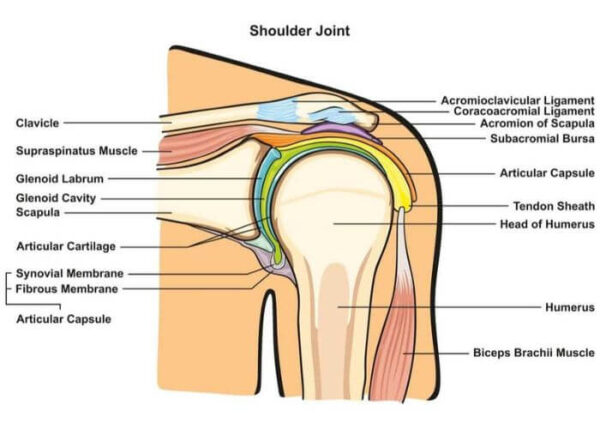Shoulder Anatomy Overview
The shoulder is considered one of the most complicated and sophisticated joints in the human body. Composed of three joints and five connected bones, the shoulder has the greatest range of motion of any joint. In order for the joint to move fluidly and pain-free, a system of ligaments and muscles work with the joints and bones to keep the shoulder joint in place. The complex shoulder anatomy causes the joint to be prone to injuries and joint pain. Shoulder specialist located in the Vail, Aspen, Colorado Springs and Denver, Colorado area, Dr. Matthew Provencher specializes in shoulder anatomy and a number of shoulder injuries and conditions.
Anatomy of the Shoulder Joint
The shoulder joint is a complex combination of bones, joints, ligaments, muscles and tendons, allowing a wide range of motion to perform everyday activities and compete in sports.
Five connected bones are associated with shoulder anatomy, including:
- Scapula (shoulder blade)
- Clavicle (collarbone)
- Humerus (upper arm bone)
- Acromion (bony projection of the shoulder blade)
- Coracoid process (hook-like bony projection off the shoulder blade)
The shoulder blade (scapula) extends up and around at the rear of the joint to form a roof-like structure, commonly known as the acromion. The shoulder blade also extends up and around the joint at the front to form the coracoid process. The glenohumeral cavity is formed where the end of the shoulder blade, known as the glenoid, meets the head of the upper arm (humerus).
The joints of the shoulder are formed by the connection of the scapula, clavicle, and humerus. These three separate joints include:
- Acromioclavicular (AC) joint: The AC joint is located at the highest point on the shoulder and provides a lifting ability.
- Sternoclavicular (SC) joint: The SC joint is located at the center of the chest and provides clavicle movement.
- Glenohumeral joint: The glenohumeral joint is formed by the connection of the scapula and the humerus and is responsible for moving the arm in and out, up and down, as well as providing arm rotation.
Each separate joint is surrounded by a sophisticated system of cartilage, ligaments, tendons, and muscles. Cartilage plays an important role in shoulder anatomy by providing a soft, pad-like surface where each bone meets. Ligaments connect the bones, while tendons attach the bones to the muscles.
The rotator cuff, a collection of tendons and muscles, holds the humerus head in a shallow cavity located in the scapula, otherwise known as the glenoid. The rotator cuff is very important to shoulder anatomy because it stabilizes the joint.
Since the shoulder is such a complex joint with great range of motion, shoulder injuries and joint pain can occur. Common causes of joint pain include:
- Rotator cuff injuries
- Shoulder impingement
- Shoulder arthritis
- Frozen shoulder
- AC joint injuries
- SC joint injuries
- Shoulder fractures
For more information on shoulder anatomy, or for additional resources on causes of joint pain, please contact the Vail, Aspen, Colorado Springs and Denver, Colorado orthopedic office of shoulder specialist Dr. Matthew Provencher.
